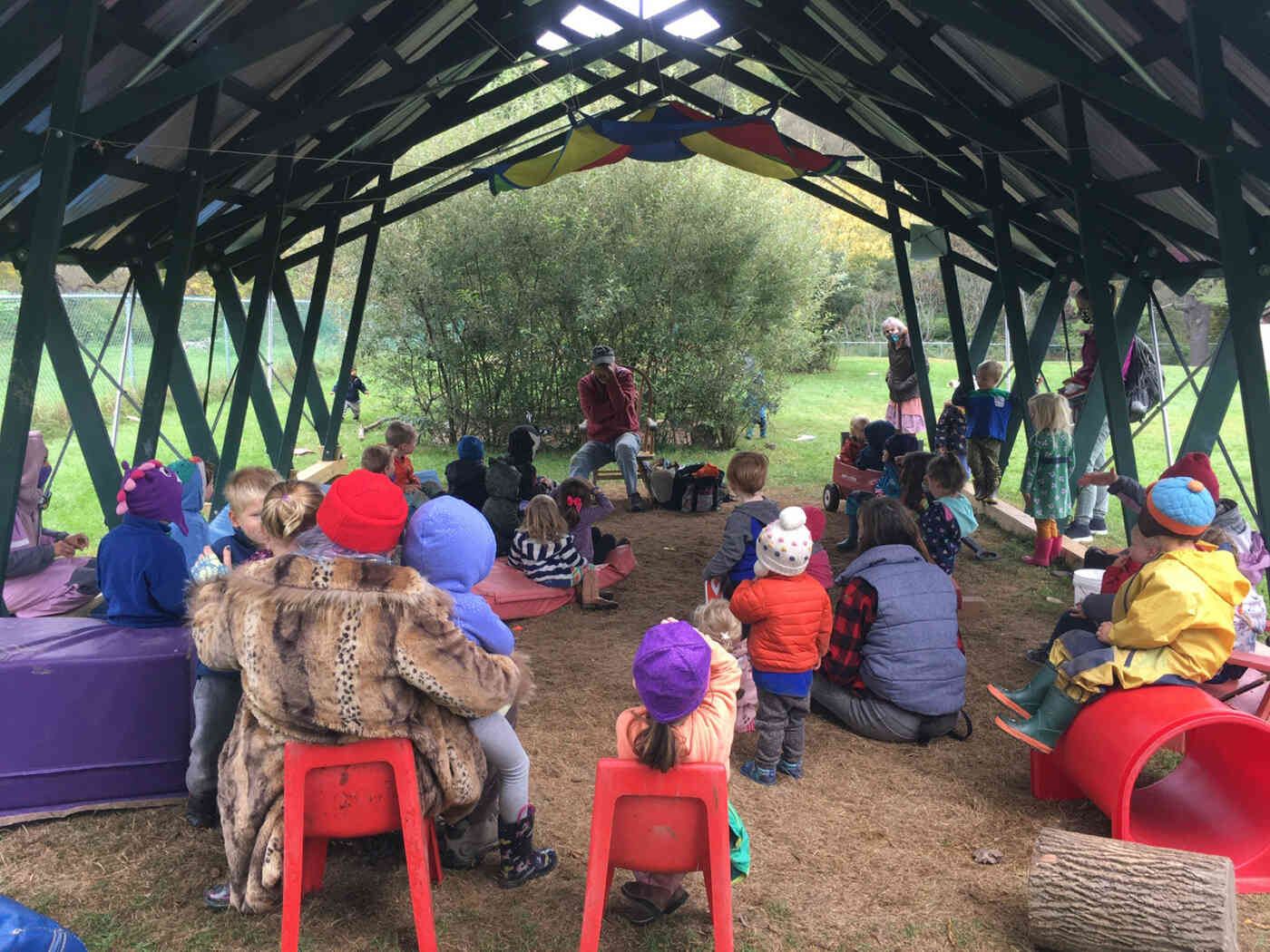
The 20-by-30-foot truss structure at the Turtle Island Children’s Center in Montpelier. Photo courtesy of Turtle Island Children’s Center
Nine outdoor classrooms designed specifically for the pandemic have been installed at schools in central Vermont, thanks to a Rochester family.
Dubbed the RyanTruss, each structure is basically a series of wooden trusses topped with a corrugated fiberglass roof. Trusses are the frames traditionally employed to support a roof.
After hearing about the need for outdoor classrooms from a teacher at the Stockbridge Central School, Greg Ryan designed a structure that would be relatively cheap and easy to assemble. Ryan, who is currently riding out the winter in New Mexico, has built tiny houses and unconventional buildings.
“I have been intrigued by how strong something could be while still being incredibly light,” said the 52-year-old builder and musician.…
This article sent us by Jon Kalish.
See earlier post on the Ryan Truss here: lloydkahn.com/lightweight-inexpensive-quick-to-build-structures
I’m going to put on a new roof soon, working by myself. Hardest part is getting the shingles up on the roof. I’m building a gable patio roof at the same time so I don’t want to rent a lift several times to load different roof areas as it progresses. While doing a search for info I came across this:
–Lew Lewandowski
A little blurry, but you get the idea. I’ve asked Lew to send us a video of his version.
Bundles of asphalt shingles are heavy!
China’s Guizhou province peering over at Mount Fanjing. Rising more than 100 meters above the surrounding landscape, visitors will need to climb almost 9,000 steps to reach the summit. Look closely at the image and you can see how the stairs wind up and around stone outcroppings and through a gorge.
The buildings you see perched at the top are two Buddhist temples — the Temple of the Buddha and the Temple of Maitreya — linked by a small footbridge.
Located in Tongren, Guizhou province, southeastern China, the highest peak of the Wuling Mountains, at 8,430 feet.
www.peapix.com/bing
More info: www.chinadiscovery.com/guizhou/fanjingshan/fanjingshan-temple.html
From Lew Lewandowski

The mighty and ever-beautiful Golden Gate Bridge. I’ve been to the top (of the south tower), as well as underneath it in a kayak journey from my home beach into San Francisco.
Plus my dad went out on a plank walkway to the south tower when it was being built in 1933.
I got a connection with this bridge!
P.S.: The true designer of the bridge was Charles Alton Ellis, not Joseph Strauss. See John Van der Zee’s book, The Gate, on the true story of this elegant design.

From David Shipway, a builder on Cortez Island, BC, Canada, regarding his catboat; his home and workshop are featured in Builders of the Pacific Coast.
It’s a fiberglass hull, modeled on a William Garden design, that has made my last 10 summers the best in my life! But as I was warned, it has definitely taken my time and attention away from maintaining some buildings here during the summer when it’s dry. I have quite a bit of roofing to do — in my 70’s now, but I’ll find some young bucks to help me.
The Humpback whale in the background of that photo is feeding on small fish that live under the aquaculture floats. These are passive shellfish enterprises, that unlike the salmon farms nearby, do not cause problems, and in fact are like floating artificial reefs, which increase the structural habitat biodiversity of this archipelago significantly, for birds, salmon and whales. Note the Bald Eagle, a white speck high above in the trees.
I built an unusual building for my Jungian Analyst and East Asian Medicine-MA partner, Laura, who had a vision. She saw a 5-sided first floor with a 6-sided second floor with a light tube or skylight through the middle. About 1600 sq. ft in all. It took me about three years to finish, and it is her offices: studio on second and meditation room on the third. Its secondary purpose is to bring geometric energies into the earth for healing of the planet. It is based on the number 11, the number of the Tao. Heaven above, earth below.
–James Ward





In 1959, an armed revolt led by Fidel Castro ousted Cuba’s military dictatorship of Fulgencio Batista. As part of a broader plan to improve the quality of life for millions of Cubans, Castro’s new government sought to develop a program to mass-produce new housing, schools and factories.
In the years that followed, however, this dream clashed with difficult realities. Sanctions and supply chain disruptions had created a shortage of conventional building materials.
Architects realized they needed to do more with less and invent new construction methods using local materials.

Three types of vaults — clockwise, from top left: conventional stone, tiled dome and tiled vault. Luis Moya Blanco, CC BY-ND
Tile vaulting is a technique that flourished in the eastern Mediterranean after the 10th century.
It involves constructing arched ceilings made of multiple layers of lightweight terra cotta tiles. To build the first layer, the builders use fast-setting mortar to glue the tiles together with barely any temporary support. Afterward, the builder adds more layers with normal cement or lime mortar. This technique doesn’t require expensive machinery or use of a lot of timber for formwork. But speed and craftsmanship are paramount.…
From Maui Surfer

Hub is Ford truck wheel.


The buildings in La Guajira, especially housing, present structural and thermal comfort problems due to the current construction materials and the underutilization of available resources in the area. Insu-ram is a system of assemblable clay blocks inspired by the cells in the elytra, or hardened wing covers, of certain beetles that allow internal air flow to circulate. Insu-ram cools and insulates a space from external heat without the use of machines and incorporates local biodegradable materials, such as rammed earth, clay, and manure to eliminate the concept of waste. The external pattern of the block generates a micro-shading effect and reduces the solar contact surface. It can be produced locally, at a low cost, is easy to replicate, and helps to solve the housing deficit in the area, while offering a way to build thermally comfortable houses in a fast, cheap, and efficient way.
Bogotá, Colombia
biomimicry.org/solution/Insu-Ram
From Rouanna Garden

At Fiumicino Rome airport. Two-passenger battery-operated helicopter meant for transporting passengers from airports to city centers. Not in operation yet.















